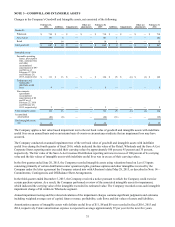Albertsons 2016 Annual Report Download - page 71
Download and view the complete annual report
Please find page 71 of the 2016 Albertsons annual report below. You can navigate through the pages in the report by either clicking on the pages listed below, or by using the keyword search tool below to find specific information within the annual report.
69
distribution centers, individual corporate store level for 28 individual corporate stores, which were part of previous asset groups
for which management determined that the cash flows in those geographic market areas were no longer interdependent, and at
the distribution center level for two distribution centers without corporate stores. Retail’s long-lived assets are reviewed for
impairment at the geographic market group level for six geographic market groupings of individual retail stores.
Due to the ongoing business transformation and highly competitive environment, the Company will continue to evaluate its
long-lived asset policy and current asset groups to determine if additional modifications to the policy are necessary. Future
changes to the Company’s assessment of its long-lived asset policy and changes in circumstances, operating results or other
events may result in additional asset impairment testing and charges.
Reserves for Closed Properties
The Company maintains reserves for costs associated with closures of retail stores, distribution centers and other properties that
are no longer being utilized in current operations. The Company provides for closed property operating lease liabilities using a
discount rate to calculate the present value of the remaining noncancellable lease payments after the closing date, reduced by
estimated subtenant rentals that could be reasonably obtained for the property. Lease reserve impairment charges are recorded
as a component of Selling and administrative expenses in the Consolidated Statements of Operations.
The closed property lease liabilities usually are paid over the remaining lease terms, which generally range from one to 15
years. Adjustments to closed property reserves primarily relate to changes in subtenant income or actual exit costs differing
from original estimates. Adjustments are made for changes in estimates in the period in which the changes become known.
The calculation of the closed property charges requires significant judgments and estimates, including estimated subtenant
rentals, discount rates and future cash flows based on the Company’s experience and knowledge of the market in which the
closed property is located, previous efforts to dispose of similar assets and the assessment of existing market conditions.
Reserves for closed properties are included in Other current liabilities and Other long-term liabilities in the Consolidated
Balance Sheets.
Deferred Rent
The Company recognizes rent holidays, including the time period during which the Company has access to the property prior to
the opening of the site, as well as construction allowances and escalating rent provisions, on a straight-line basis over the term
of the operating lease. The deferred rents are included in Other current liabilities and Other long-term liabilities in the
Consolidated Balance Sheets.
Self-Insurance Liabilities
The Company uses a combination of insurance and self-insurance for workers’ compensation, automobile and general liability
costs. It is the Company’s policy to record its insurance liabilities based on management’s estimate of the ultimate cost of
reported claims and claims incurred but not yet reported and related expenses, discounted at a risk-free interest rate. The
present value of such claims was calculated using discount rates ranging from 0.3 percent to 5.1 percent for fiscal 2016, 0.3
percent to 5.1 percent for fiscal 2015 and 0.3 percent to 5.1 percent for fiscal 2014.
Changes in the Company’s insurance liabilities consisted of the following:
2016 2015 2014
Beginning balance $ 93 $ 103 $ 97
Expense 29 31 34
Claim payments (28)(32)(33)
Reclassification of insurance recoveries to receivables 1 (9) 5
Ending balance 95 93 103
Less current portion (31)(30)(33)
Long-term portion $ 64 $ 63 $ 70
The current portion of reserves for self-insurance is included in Other current liabilities and the long-term portion is included in
Other long-term liabilities in the Consolidated Balance Sheets. The insurance liabilities as of the end of the fiscal year are net of
discounts of $6 and $6 as of February 27, 2016 and February 28, 2015, respectively. Amounts due from insurance companies
were $11 and $9 as of February 27, 2016 and February 28, 2015, respectively. The current portion of the insurance receivables
is included in Receivables, net and the long-term portion is included in Other assets in the Consolidated Balance Sheets.
























